|





























|
 |


My Electronics Workbenches
Several people have asked me what test equipment and tools I use on my bench to work on antique radios, vintage test equipment, and electronics.
Although the configuration and equipment I use has changed over time, here are photos and descriptions of some of the equipment and tools I
currently use on my electronics workbenches to restore antique radios and vintage test equipment for my collection.
|
Main Workbench
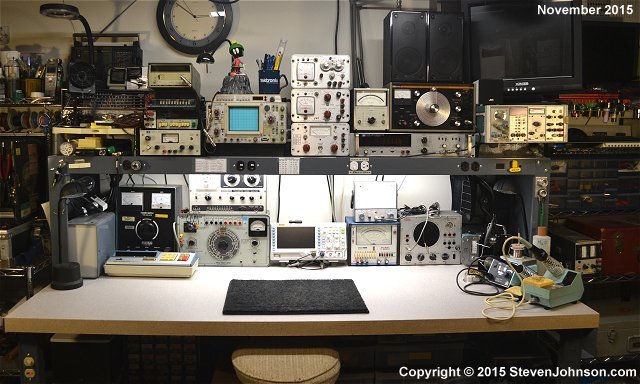
Larger Photo Latest Photo: November 2015
November 2015 - Whats What:
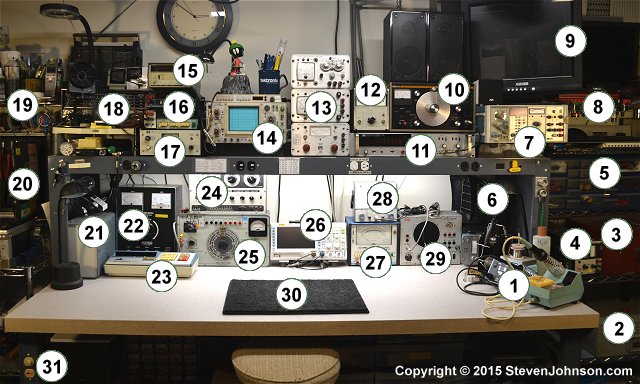
1. Weller WTCPN and WESD51 Soldering Stations
2. Supreme I177 B Military Tube Tester
3. Hickok 6000B Mutual Conductance Tube Tester
4. Kerco High Current DC Power Supply
5. Adapter Storage
6. Weller Soldering Fume Extractor
7. Tektronix 504 Rack with:
Tek FG503 Function Generator
Tek DM501A DMM
Tek DC504 Counter/Timer
Tek PS503A Dual DC Power Supply
8. Tube Socket Adapters
9. Networked Computer
10. B&K E200D Signal Generator
11. HP Nixie Tube Frequency Counter/Timer/DVM
12. HP 400EL AC RMS Voltmeter
13. Power Designs DC Power Supplies (3)
|
 |
14. Tektronix 465DM Analog Oscilloscope
15. Hewlett Packard 5381A Frequency Counter
16. Fluke 8000A & 8800A DVMs
17. HP 6289A DC Power Supply
18. Hallicrafters S-12 Receiver
19. Wire and supplies
20. Xcelite Tool Kit
21. Isolation Transformer
22. Staco Variac AC Power Supply
23. Remington Nixie Tube Calculator
24. B&K 960 Transistor Radio Tester
25. Sprague TO-5 Capacitor Tester
26. Rigol DS1074Z Digital Oscilloscope
27. Hickok 5720 FET Multi-Meter
28. RCA WV-98C Vacuum Tube Voltmeter
29. Eico 147A Signal Tracer
30. Carpet Square for chassis rotating
31. Bench Master On/Off Switch
|
Micro Soldering Work Station
As my eyes have gotten older, electronics has gotten smaller. Also, when working on the newer sensitive components and circuit
boards, static can be a problem. Not only are the new surface mount devices smaller and harder to work with but many can be ruined
by just a small static discharge. This ESD (ElectroStatic Discharge) safe soldering station I put together includes an inspection microscope for working on tiny surface mount components
and ESD safe soldering and desoldering tools. This equipment would have taken up too much room on the main bench so I decided to make it a separate workstation.
|
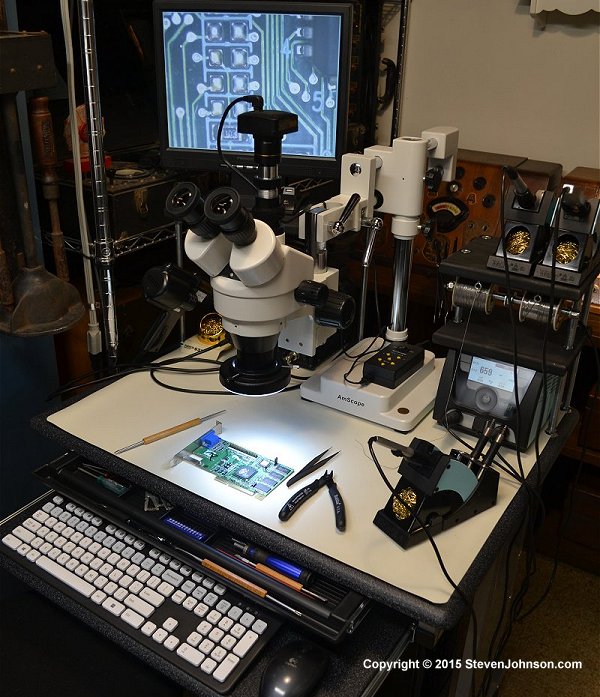 |
November 2013 - Whats What:
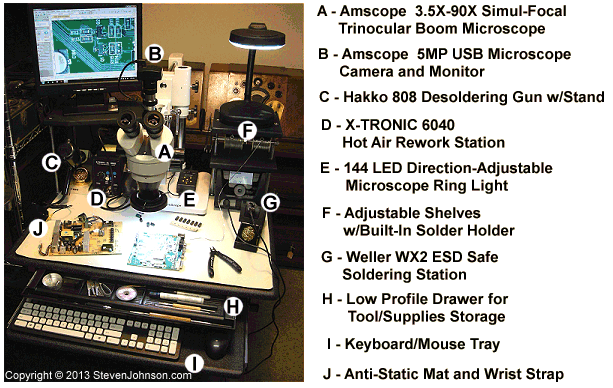 |
Building my ESD Safe Soldering Work Station.
More information on my Soldering Irons and Soldering Guns.
Analog and Digital Oscilloscopes
Tektronix 465 DM44
Rigol DS1074Z

My vintage Tektronix 465 DM44 analog oscilloscope (above left) is my favorite scope for signal tracing and troubleshooting.
My new Rigol DS1054Z 4 channel Digital Oscilloscope makes an easy job of analyzing every parameter of a signal at the press
of a button and capturing the screenshot on a thumb drive or viewing the screen on a large computer display.
|
Supreme I-177 B Tube Testers Hickok 6000A
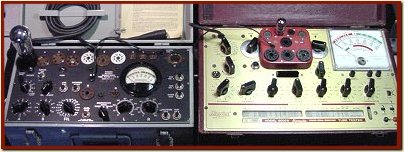
Mutual Conductance Tube Testers
I use a Hickok 6000A tube tester (above right) to test most newer tubes (12AX7A, 6X4, etc.). It has a roll chart listing settings for
most tubes it tests. I also have additional Hickok data for testing obsolete and foreign tubes.
 |
 |
My Supreme Instruments I-177 B tube tester (above left) is used to test most older vacuum tubes including antique 4 and 5 pin tubes
(01A, 83, etc.). The I-177 series testers were well built, military testers which utilized the mutual conductance test circuits designed by Hickok. They were produced by several manufactures for
the military including Hickok and Supreme Instruments. This I-177 B was manufactured by Supreme around 1950 and has a booklet with the tube settings in the cover. My Supreme Instruments Collection
|
You might also see a Triplett 2413 tube tester on the bench that I use for non-critical "quick checks" like shorts and open/close checks on eye
tubes. This reduces the wear and tear on my more expensive tube testers.
Test data for all my tube testers
is stored and searchable on the workbench computers to speed up finding tube settings and reduce the
wear and tear on the testers paper roll charts and booklets. I also have over 100 early tube testers from various manufacturers in my
Vintage Test Equipment Collection.
|
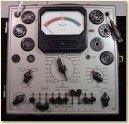
|
Many older radios and some radio test equipment were wired with a "Hot" chassis. An upper workbench AC outlet is isolated from the main AC power through a 500VA isolation transformer.
This helps protect me from shocks when working on old radios. The variable AC supply (VARIAC) lets me bring the voltage up slowly in older equipment when I first power it up to help
limit damage to the circuits if a component fails.
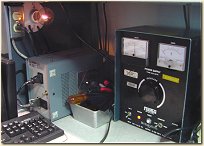 Voltage and current meters on the variable AC supply allow me to monitor the power draw as the line voltage is brought up.
Voltage and current meters on the variable AC supply allow me to monitor the power draw as the line voltage is brought up.
A 100 watt incandescent light bulb is also kept in series with the AC supply line to act as a ballast.
If a radio starts to draw too much current as the voltage is increased, the amp meter reading on the supply will increase and the ballast light bulb will increase in brightness and let me know there is a problem.
I use a clear glass bulb so I can easily see any change in the filament's glow. If there is a direct short in the equipment the bulb protects the output of the variac by taking the entire load and glows at full brightness.
If you don't have a variac, you can bring voltage up in steps using a "Dim Bulb Tester" that you can construct for just a few
dollars with some light bulbs, a cord, and an AC socket.
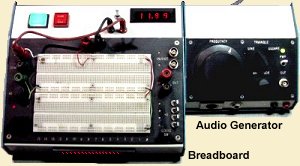 Some equipment I build myself (not kits).
This audio generator helps test amplifier circuits and sound equipment.
It produces sine, triangle, and square waves with adjustable audio frequency and amplitude.
Some equipment I build myself (not kits).
This audio generator helps test amplifier circuits and sound equipment.
It produces sine, triangle, and square waves with adjustable audio frequency and amplitude.
|
I built the breadboard above to test transistor and digital circuits and to
temporarily replace components in low voltage circuits under repair. It has a fixed 5V power
supply, an adjustable +/- DC supply, a pulse generator, LEDs for monitoring digital circuit status,
plenty of switches and I/O connectors for jumpers, and a Digital Volt Meter.
This simple "Lamp Test Jig" which I made with several different style lamp
sockets and connectors for meters and power supplies, saves me a
lot of time testing lamps. I can easily test filaments and current draw on bulbs and
fuse lamps without using a mess of jumpers and alligator clips.
|
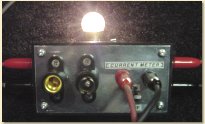
GE #81 Fuse Lamp under current test
|
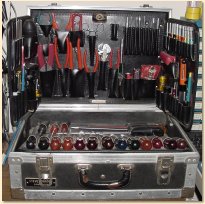 |
 |
This Xcelite tool kit keeps all my hand tools organized. The original Xcelite TC-100 tool kit came in a
briefcase. I had an Anvil road case custom made for it that is deep enough under the tool pallet to store larger items,
meters, and testers - larger photo. Its held up well despite several years on the road when
I was a pro sound engineer. I think that if the house was burning and I could only grab one thing
from my antique radio collection or workbench, this would be it.
See more of the tools and meters I use here.
|
I use two Weller soldering stations on the workbench along with Weller soldering guns for heavier duty soldering.
You can check out some of my antique and vintage soldering tool collection here:
Soldering Tools, Irons, and Guns
and soldering tools I use on my bench here.
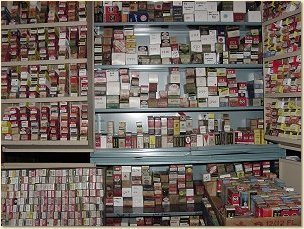 |
Several thousand vacuum tubes are kept for rebuilding
radios and vintage test equipment. Once tubes are tested,
they are stored in my tube cabinet (an old auto parts cabinet) or in one
of my Radio/TV repairman's tube caddies.
|
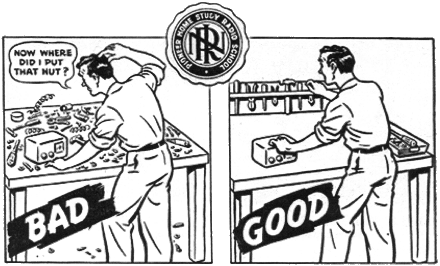 I've been asked why my repair bench looks so neat and clean.
All I can say is when I need something, I don't like looking all over for it. Just ask the kids...
I've been asked why my repair bench looks so neat and clean.
All I can say is when I need something, I don't like looking all over for it. Just ask the kids...
My repair bench computer contains files of updated tube testing data for all my tube testers along with thousands of radio and test
equipment schematics, parts lists, and dial string diagrams. Internet access comes in handy when I have to
search for additional information or manuals I don't already have in my service library.
The web site work and digitizing of service manuals is done on separate computers in my office. All
computer workstations in the office and shop are networked for sharing files of equipment data and for Internet access.
|
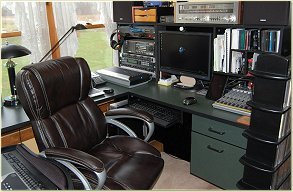
One of my networked office workstations
|
|
I keep an extensive library of over 500,000 original factory service manuals, Photofacts, and
schematics covering radios, amplifiers, phonographs, and test equipment from the 1920's, 30's, 40's and 50's.
My collection includes complete libraries of service information published by Gernsback, Riders, Beitman, and the original factory service manuals from major manufactures such as Crosley, RCA Victor,
Motorola, Philco, GE, Marconi, Atwater-Kent, Voice of Music, Zenith and many others.
I also have vacuum tube manuals, tube substitution books, and cross reference manuals for finding information
such as tubes cross referenced by manufacture, model, number of tubes and type for help in identifying unmarked radios.
If you need schematics or service information for restoring your antique radio visit my factory service manual site at:
www.AntiqueRadioSchematics.org
Originals and downloads of Photofact service manuals for radios, amplifiers, and record players manufactured after World War II are available at my Photofacts web site: TheSchematicMan.com
|
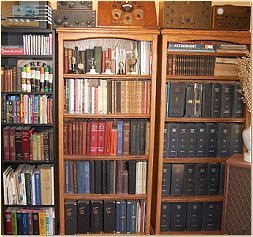 |
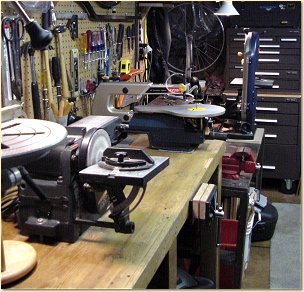
|
My Wood Shop
Sawdust, striping chemicals, and drill bit shavings don't mix well with electronics and test equipment
so I keep them far away from each other. All radio cabinet repair, refinishing, and any chassis metal work
is done out in my wood shop.
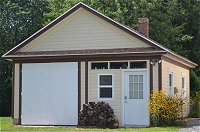
A drill press, belt and disk sander, scroll saw, router table, and band saw are my most used power tools for cabinet repair.
|
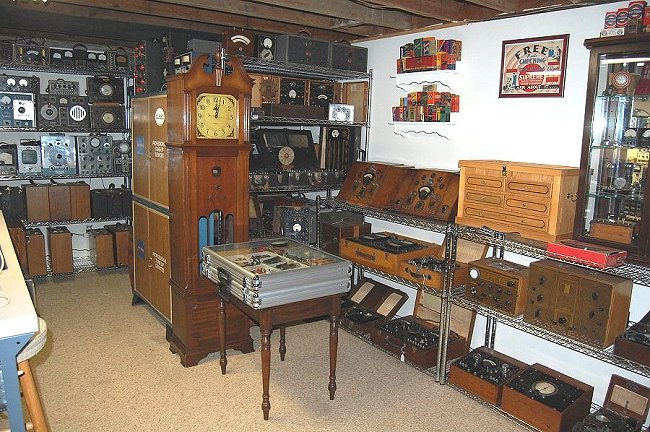 Remember to check out some of my vintage Test Equipment Collection.
Remember to check out some of my vintage Test Equipment Collection.
Here are some tips on what you might need to get started: Antique Radio Workbench Basics
Check out some Early Radio Workbench Photos
Antique radio collecting can be a fun hobby. Even if you start out with
just a few hand tools, a simple meter and an old desk in the basement, getting that vintage radio working you found
at a garage sale is a very rewarding experience.
|
|
|
|










 Voltage and current meters on the variable AC supply allow me to monitor the power draw as the line voltage is brought up.
Voltage and current meters on the variable AC supply allow me to monitor the power draw as the line voltage is brought up. Some equipment I build myself (not kits).
This audio generator helps test amplifier circuits and sound equipment.
It produces sine, triangle, and square waves with adjustable audio frequency and amplitude.
Some equipment I build myself (not kits).
This audio generator helps test amplifier circuits and sound equipment.
It produces sine, triangle, and square waves with adjustable audio frequency and amplitude.








 Remember to check out some of my vintage
Remember to check out some of my vintage